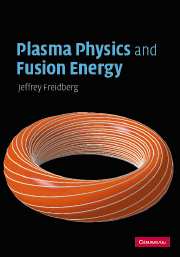Book contents
- Frontmatter
- Contents
- Preface
- Acknowledgements
- Units
- Part I Fusion power
- Part II The plasma physics of fusion energy
- 6 Overview of magnetic fusion
- 7 Definition of a fusion plasma
- 8 Single-particle motion in a plasma – guiding center theory
- 9 Single-particle motion – Coulomb collisions
- 10 A self-consistent two-fluid model
- 11 MHD – macroscopic equilibrium
- 12 MHD – macroscopic stability
- 13 Magnetic fusion concepts
- 14 Transport
- 15 Heating and current drive
- 16 The future of fusion research
- Appendix A Analytical derivation of 〈ς v〉
- Appendix B Radiation from an accelerating charge
- Appendix C Derivation of Boozer coordinates
- Appendix D Poynting's theorem
- Index
- References
12 - MHD – macroscopic stability
Published online by Cambridge University Press: 14 May 2010
- Frontmatter
- Contents
- Preface
- Acknowledgements
- Units
- Part I Fusion power
- Part II The plasma physics of fusion energy
- 6 Overview of magnetic fusion
- 7 Definition of a fusion plasma
- 8 Single-particle motion in a plasma – guiding center theory
- 9 Single-particle motion – Coulomb collisions
- 10 A self-consistent two-fluid model
- 11 MHD – macroscopic equilibrium
- 12 MHD – macroscopic stability
- 13 Magnetic fusion concepts
- 14 Transport
- 15 Heating and current drive
- 16 The future of fusion research
- Appendix A Analytical derivation of 〈ς v〉
- Appendix B Radiation from an accelerating charge
- Appendix C Derivation of Boozer coordinates
- Appendix D Poynting's theorem
- Index
- References
Summary
Introduction
The second main application of the MHD model concerns the problem of macroscopic stability. The starting point is the assumption that a self-consistent MHD equilibrium has been found that provides good plasma confinement. The stability question then asks whether or not a plasma that has been initially perturbed away from equilibrium would return to its original position as time progresses. If it does, or at worst oscillates about its equilibrium position, the plasma is considered to be stable. On the other hand, when a small initial perturbation continues to grow, causing the plasma to move further and further away from its equilibrium position, then it is considered to be unstable.
For a fusion reactor MHD stability, particularly ideal MHD stability, is crucial. The reason is that ideal MHD instabilities often lead to catastrophic loss of plasma. Specifically, the plasma moves with a rapid, coherent bodily motion directly to the first wall. The resulting loss of plasma combined with the potential damage to the first wall has led to a consensus within the fusion community that ideal MHD instabilities must be avoided in a fusion reactor.
How are such instabilities avoided? In general, plasma stability is improved by limiting the amount of pressure or toroidal current. However, high pressure is desirable in order to achieve high pτE in a reactor, and high current, as will be shown, is desirable for increasing τE. MHD stability theory is thus concerned with two basic problems.
- Type
- Chapter
- Information
- Plasma Physics and Fusion Energy , pp. 296 - 332Publisher: Cambridge University PressPrint publication year: 2007



